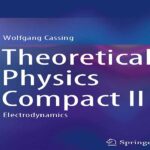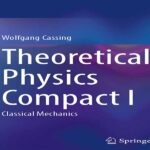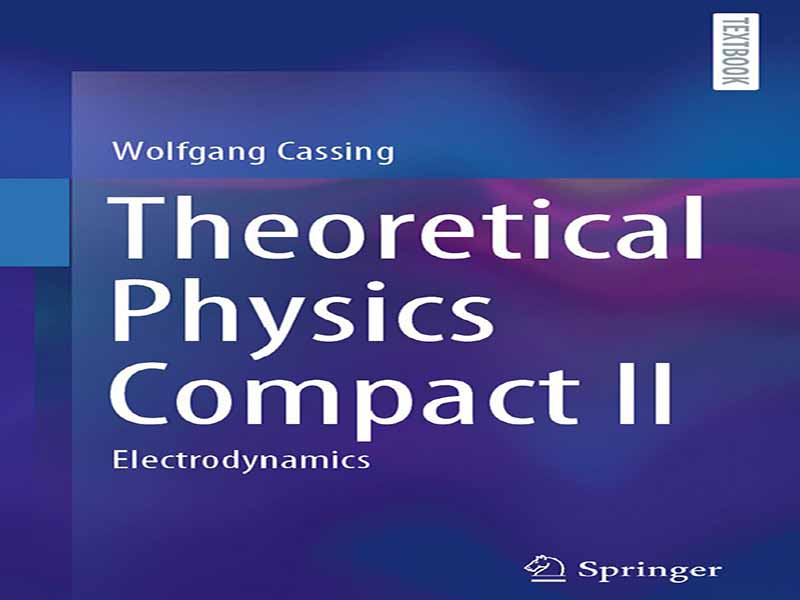- عنوان کتاب: Theoretical Physics Compact II -Classical Mechanics
- نویسنده: Wolfgang Cassing
- حوزه: فیزیک نظری
- سال انتشار: 2025
- تعداد صفحه: 199
- زبان اصلی: انگلیسی
- نوع فایل: pdf
- حجم فایل: 3.79 مگابایت
این کتاب یک کتاب درسی در مورد الکترودینامیک ارائه میدهد و به ویژه برای دانشجویان کارشناسی در سال دوم تحصیل در رشته فیزیک نظری مناسب است. الزامات ریاضی شامل دانش مشتقگیری و انتگرالگیری، جبر خطی مقدماتی و مفاهیم آنالیز برداری است. اثباتهای ریاضی تا حد امکان ساده نگه داشته شدهاند، با این حال، همچنان دقیق نگه داشته شدهاند. پس از معرفی مفهوم «بار» نقاط جرم و استراتژیهای اندازهگیری «بار»، میدان الکتریکی E(r) برای یک سیستم از بارهای نقطهای ششتایی یا توزیع بار پیوسته ρ(r) (الکترواستاتیک) تعریف و مورد بحث قرار میگیرد. نشان داده میشود که واگرایی میدان الکتریکی متناسب با چگالی بار ρ(r) است و خود میدان به عنوان گرادیان منفی پتانسیل اسکالر Φ(r) ظاهر میشود. با ترکیب این یافتهها، معادله پواسون برای توزیع بارهای استاتیک استخراج میشود. در مورد جریانهای ثابت j(r) یک میدان مغناطیسی B(r) ظاهر میشود که برای مثالهای ساده (مغناطیس استاتیک) مورد بحث و ارزیابی قرار میگیرد. مشخص شده است که این میدان با یک واگرایی صفرشونده مشخص میشود و بنابراین میتوان آن را به صورت چرخش یک میدان برداری A(r) نوشت. در مورد توزیع بار وابسته به زمان ρ(r;t) و جریانهای j(r;t) منابع توسط یک معادله پیوستگی کوپل میشوند که به معنای پایستگی بار کل است. در این مورد (الکترودینامیک)، میدانهای الکتریکی و مغناطیسی از طریق قانون القای فارادی کوپل میشوند و معادلات اساسی برای میدانهای E و B به شکل معادلات ماکسول ظاهر میشوند که – همراه با نیروی لورنتس – الکترودینامیک را در سطح کلاسیک به طور کامل توصیف میکنند. با این حال، حل مستقیم این معادلات دیفرانسیل کوپل شده دشوار است. با معرفی پتانسیلهای اسکالر و برداری وابسته به زمان، معادلات موج عمومی Φ(r;t) و A(r;t) با بهرهگیری از این واقعیت که این پتانسیلها دارای آزادی پیمانهای هستند، استخراج میشوند، یعنی در صورت تبدیل پیمانهای، میدانهای E و B یکسانی را ارائه میدهند. در این زمینه، قراردادهای کولن و لورنتس (سنجهها) مورد بحث قرار میگیرند. علاوه بر این، نشان داده میشود که انرژی، تکانه و تکانه زاویهای باید به میدان الکترومغناطیسی اختصاص داده شوند و فشار تابشی برای میدانهای تابشی ظاهر میشود. این امر راه را برای تفسیر میدانها به عنوان «فوتون» یا «γ-کوانتا» هموار میکند. معادلات موج ابتدا در خلاء، یعنی بدون منابع خارجی، حل میشوند و امواج صفحهای قطبیده به عنوان راهحلهای اساسی یافت میشوند که با فرکانس زاویهای ω، عدد موج k و بردار قطبش عمود بر جهت انتشار k مشخص میشوند. سپس یک برهمنهی از امواج صفحهای – بر حسب سری فوریه – راهحل کلی در خلاء را بر حسب بستههای موج ارائه میدهد که میتواند برای انتقال اطلاعات استفاده شود. راهحل کلی معادلات موج ناهمگن با کمک توابع گرین عقبمانده به دست میآید که منجر به پتانسیلهای عقبمانده معروف به پتانسیلهای لینارد-ویچرت میشود. یک راهحل برای سیستمی از بارهای نقطهای متحرک به طور صریح محاسبه شده و نشان داده شده است که بارهای شتابدار، تابش الکترومغناطیسی تولید (یا جذب) میکنند. مورد اخیر با توجه به فرکانس ω و توزیع زاویهای برای تابش دوقطبی الکتریکی و مغناطیسی و همچنین برای تابش چهارقطبی الکتریکی تجزیه و تحلیل میشود.
This book provides a textbook on electrodynamics and is in particular suited for bachelor students in their second year of studies in theoretical physics. The mathematical requirements include a knowledge of differentiation and integration, elementary linear algebra and concepts of vector analysis. Mathematical proofs are kept as simple as possible, however, still kept stringent. After introducing the concept of ‘charge’ of mass points and strategies to measure ‘charge’ the electric ield E(r) is deined and discussed for a system of ixed point charges or a continuous charge distribution ρ(r) (electrostatics). It is shown that the divergence of the electric ield is proportional to the charge density ρ(r) and the ield itself emerges as the negative gradient of the scalar potential Φ(r). By combining these indings the Poisson equation is derived for static charge distributions. In the case of constant currents j(r) a magnetic ield B(r) emerges that is discussed and evaluated for simple examples (magnetostatics). This ield is found to be characterized by a vanishing divergence and thus can be written as the rotation of a vector ield A(r). In case of time-dependent charge distributions ρ(r;t) and currents j(r;t) the sources are coupled by a continuity equation, which implies the conservation of the total charge. In this case (electrodynamics) the electric and magnetic ields are coupled via Faraday’s law of induction and the basic equations for the E and B ields emerge in the form of Maxwell’s equations, which—together with the Lorentz force—completely describe electrodynamics on the classical level. However, these coupled differential equations are dificult to solve directly. By introduction of time-dependent scalar and vector potentials Φ(r;t) and A(r;t) general wave equations are derived by exploiting the fact, that these potentials have a gauge freedom, i.e. they provide the same E and B ields in case of gauge transformations. In this context the Coulomb and Lorentz conventions (gauges) are discussed. It is, furthermore, shown that energy, momentum and angular momentum have to be assigned to the electromagnetic ield and that a radiation pressure appears for radiation ields. This paves the way for an interpretation of the ields as ‘photons’ or ‘γ-quanta’. The wave equations are irst solved in vacuum, i.e. without external sources, and polarized plane waves are found as basic solutions, that are characterized by an angular frequency ω, a wave number k and a polarization vector orthogonal to the direction of propagation k. A superposition of plane waves—in terms of a Fourier series—then provides the general solution in vacuum in terms of wave packets, which can be used for the transmission of information. The general solution of the inhomogeneous wave equations is obtained with the help of retarded Green’s functions, that lead to the retarded potentials known as Liénard—Wichert potentials. A solution for a system of moving point charges is computed explicitly and it is shown that accelerated charges produce (or absorb) electromagnetic radiation. The latter is analyzed with respect to the frequency ω and angular distribution for electric and magnetic dipole radiation as well as for electric quadrupole radiation.
این کتاب را میتوانید از لینک زیر بصورت رایگان دانلود کنید:
Download: Theoretical Physics Compact II -Classical Mechanics



































نظرات کاربران